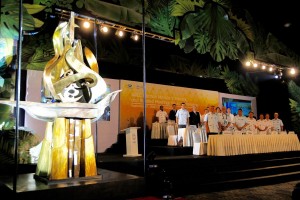
(Eagle News) —Finance Ministers of the Asia-Pacific Economic Cooperation (APEC) concluded the 22nd meeting by launching the Cebu Action Plan, a roadmap for a more sustainable financial future for the Asia-Pacific region.
Finance Secretary Cesar V. Purisima said that the “Cebu Action Plan” (CAP) that was launched on Friday, Sept. 11 was the “work of a region facing forward in steadfast cooperation amid complex challenges and opportunities.”
“We hope the CAP emerges as the lasting legacy of the Philippines’ hosting. With 21 economies, multilateral institutions, and private sector support behind it, we are optimistic the CAP can be taken in the next meetings as a living body of continuing work in our bid for a more prosperous, financially integrated, transparent, resilient, and connected Asia-Pacific,” he said.
The CAP, which will be submitted to the APEC Leaders, has four pillars: (i) promoting financial integration; (ii) advancing fiscal reforms and transparency; (iii) enhancing financial resilience; and (iv) accelerating infrastructure development and financing.
The CAP continues the progress towards the Bogor Goals of free and open trade and investment.
The Bogor goals refer to the commitments made when APEC Leaders gathered in Bogor, Indonesia in 1994. These commitments are for the achievement of free and open trade and investment by 2010 for industrialized economies, and by 2020 for developing economies. APEC members agreed to pursue this goal by further reducing barriers to trade and investment and by promoting the free flow of goods, services and capital.
In the Cebu Action Plan, which was in furtherance of the Bogor Goals, economies committed to work towards more liberalized financial services and capital accounts across Asia-Pacific. Likewise, economies emphasized how promoting trade and supply chain finance, as well as alternative financing mechanisms in APEC can boost inclusive growth, especially in improving access to finance for micro, small, and medium enterprises, 40% of which are underserved in the region. In fighting poverty, economies seek to leverage financial inclusion strategies to protect the most vulnerable.
In a news release, the APEC Finance Ministers agreed that fiscal transparency and reforms figure in optimizing public investments across the region. It said regional cooperation on taxation and governance reforms will help ensure that available fiscal space are dedicated towards growth-inducing investments.
“In a region where more than 60% of the world’s disasters strike with costs of damages reaching $1.2 trillion in the past decade alone, economies committed to enhance financial resilience by building deeper financial markets. Finance Ministers are confident that resiliency can be bolstered through the development of innovative disaster risk financing and insurance mechanisms, and other risk transfer instruments available through the capital markets,” it said.
Finance Ministers looked forward to the development of an APEC PPP knowledge portal in collaboration with the Global Infrastructure Hub. This will serve as an online repository of PPP Infrastructure projects.
This is in recognition of the heightened role quality infrastructure played in a growing region.
Finance Ministers also noted how developing quality infrastructure can be an asset class for institutional and long-term investors in the APEC region. They said this can facilitate the mobilization of regional savings into long-term investment pools.
Before concluding the day, APEC Finance Ministers unveiled a marker to commemorate the Cebu Action Plan. The marker is a 2-meter tall sculpture of pounded brass on 4 black granite pedestals representing the CAP pillars.
“With the conclusion of our hosting, we demonstrate the upside to regional collaboration. We thank all 20 other member economies, our friends from multilateral institutions, and the private sector for joining us as we forge Asia-Pacific’s financial future,” Purisima said.
The 23rd Finance Ministers’ Meeting will be held in Lima, Peru in October 2016. (based from DOF news release)







